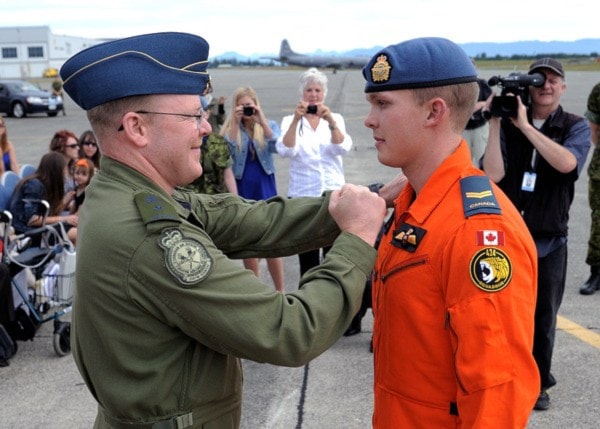Following almost a year of some of the most intensive training in the Canadian Forces, Master-Corporal Matthew Davidson from Courtenay has received his Search and Rescue Technician (SARTech) wings and distinctive orange beret.
MCpl Davidson joined the Canadian Forces in 2006 as a medical technician and served with 1 Field Ambulance based at Canadian Forces Base Edmonton. He served in Kandahar, Afghanistan in 2009 as a platoon medic. Following his tour to Kandahar, he set out for a new challenge as a Search and Rescue Technician.
“I faced many challenges, but had great experiences on course,” said MCpl Davidson. “I can’t thank my family and friends enough for their constant encouragement since I started on this goal.”
The road to become a SARTech was not a short or easy one. It started with a pre-selection process conducted in Edmonton and Jarvis Lake, Alta. From a group of 31 hopefuls trying to become the next generation of SARTechs, only eight actually became candidates on course. From there, the real challenge started.
“The whole course was rewarding, you learn so many different skills and you learn a lot about yourself at the same time,” said Davidson. “The most challenging part for me was the Arctic survival phase. It’s unforgiving up there and you can’t just look out for yourself, you have to look out your buddies, and be prepared to look after casualties at the same time.”
Davidson will be posted to 424 Transport and Rescue Squadron in Trenton, Ont.
SARTech training is run by the Canadian Forces School of Search and Rescue, located at 19 Wing, Canadian Forces Base Comox.
The school prepares SARTech candidates to perform life-saving missions throughout Canada, in some of the harshest weather and environmental conditions. Whether they are jumping into surf from a helicopter, rappelling down a cliff, parachuting into arctic winds or scuba diving into murky waters, SARTechs are known for their ability to reach those in need.
“At the end of the selection phase I knew that I had a very strong group to work with. They arrived on course from a variety of backgrounds and jelled as a team very early,” said Sgt. Paul Moquin, senior instructor for SARTech Course 45. “Their dedication to the SAR Tech profession and to each other has been proven time and again and I am proud to say that I was their course NCO.”
The Canadian Forces annually responds to approximately 8,000 incidents, tasking military aircraft or ships in about 1,100 cases. As primary care providers, SAR Techs travel on all military SAR aircraft.
The Canadian Forces’ responsibility for aeronautical and maritime SAR extends over 15 million square kilometres of land and sea — an area one-and-a-half times that of Canada’s landmass.
— 19 Wing Comox
